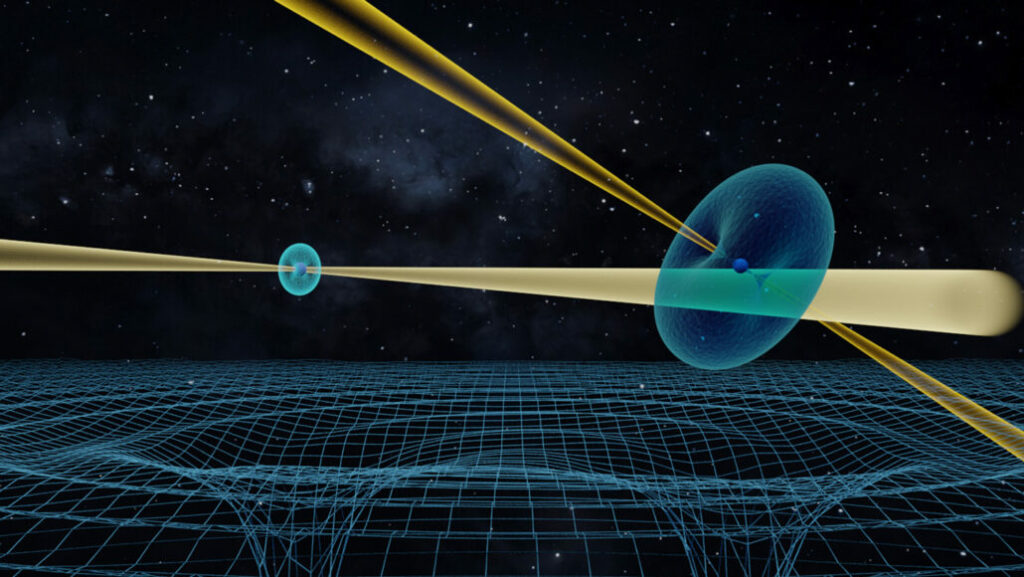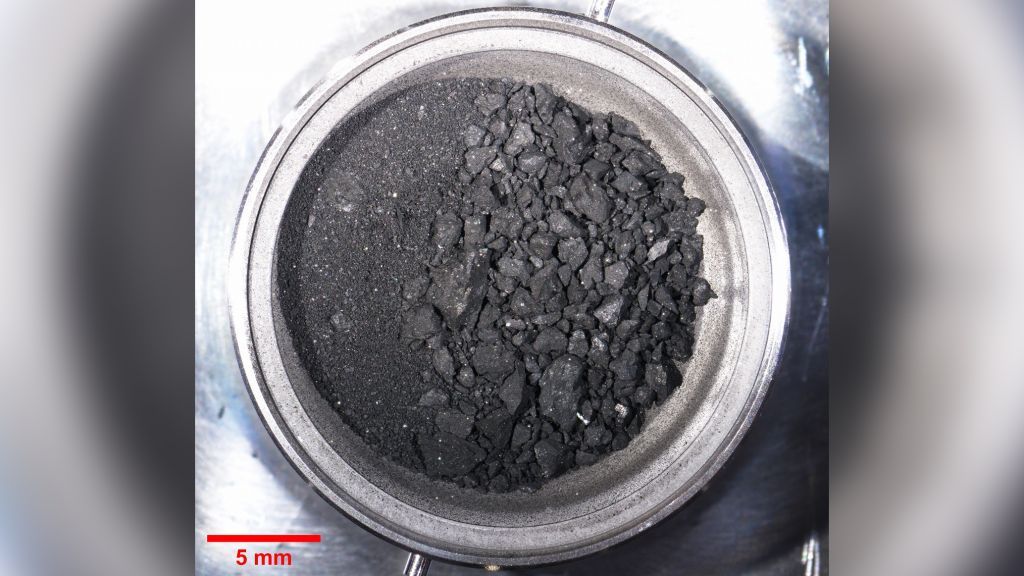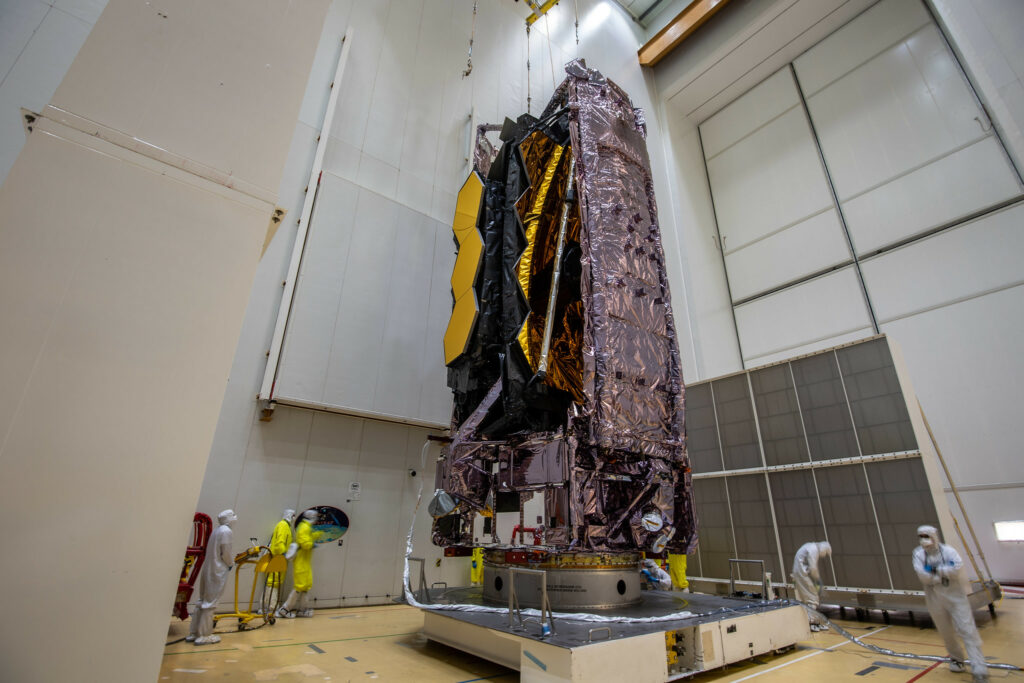Dr. Pamela takes a deep dive into her feelings about the JWST, its pending launch, and just what the telescope means to the astronomical community. Plus, general relativity is still true, a huge filament of gas in the Milky Way, and we interview Hamed Valizadegan, project lead for ExoMiner.
Podcast
Show Notes
Relativity: It’s still true. Really.
- MPIFR press release
- The only known pulsar duo sheds new light on general relativity and more (Science News)
- “Strong-Field Gravity Tests with the Double Pulsar,” M. Kramer et al., 2021 December 13, Physical Review X
Found: A 3,900 light-year filament of gas
- MPIA press release
- “The “Maggie” filament: Physical properties of a giant atomic cloud,” J. Syed et al., 2021 December 20, Astronomy & Astrophysics
Ryugu made of raw materials that resemble pepper
- Bits of asteroid Ryugu are among ‘most primordial’ materials ever examined (Live Science)
- “First compositional analysis of Ryugu samples by the MicrOmega hyperspectral microscope,” C. Pilorget et al., 2021 December 20, Nature Astronomy
- “Preliminary analysis of the Hayabusa2 samples returned from C-type asteroid Ryugu,” Toru Yada et al., 2021 December 20, Nature Astronomy
JWST set to launch on Christmas Eve
Transcript
Hello and welcome to the Daily Space. I am your host Dr. Pamela Gay.
And I am your host Beth Johnson.
And we are here to put science in your brain.
Now, we know that all of you have JWST on your mind, and we promise we’re going to talk about it, but today’s episode still has news to get to, and a guest to talk to.
Joining us later on in the show is Hamed Valizadegan, the project lead for ExoMiner and a machine learning manager with the Universities Space Research Association at NASA Ames Research Center. He’ll be here to talk with us about the ExoMiner project and what it is doing for the search for exoplanets.

As a science communicator, there are certain emails I have come to expect. By and large, the most common of these emails are the, “Hi, I need help with my math, but I have a solid explanation for why relativity is wrong, and I just need you to do the math for me” emails.
First of all, I have no idea what I have done that would ever make someone think I’m willing to do theoretical physics as a favor for them. Second, relativity is true, and while it has some not well-defined corners, the parts of it that we have worked out have been proven over and over and over through myriad experiments.
One of the best laboratories is naturally occurring. Sixteen years ago, astronomers discovered a pair of pulsars in a binary system. These fast-rotating stars are like cosmic metronomes, with one flashing the beat every 44 seconds while the other does so every 2.8 seconds. While the stars themselves, in their pockets of time and space, are the most perfect metronomes in the universe, what we see is affected by the distortions of relativity. A quick glance may not reveal these effects, but over the past sixteen years those distortions have added up to yet more definitive proof that Einstein was right.
Over the years, researchers have been able to watch the elliptical orbits rotate so that the long axis of the orbit changes its alignment. What they see matches relativity perfectly, in all its finest details. They can also see the orbits shrinking as they radiate away energy in the form of gravitational waves.
And here’s the thing: since energy and mass are the same things, this lost energy is no different than lost mass. This is the first system that can be measured so precisely that this matters. This system has a lot of firsts. The effects of frame dragging actually make it possible to figure out the radius of the faster of the two pulsars, and that radius is just 22 kilometers or almost 14 miles.
One set of maths – general relativity – is able to completely and consistently explain this system. Nothing else can do it. General relativity is true. So please, stop emailing me your alternatives and asking me to do your maths. Einstein was right, and the Universe has complex order we need to savor.
This work was led by Matt Kramer and appears in a pair of papers in Physical Review X.
Outer space defies a lot of what seems like common sense based on how we humans experience the universe from the surface of our planet. Things like “gas” take on an entirely different meaning when their motions are dominated by gravity instead of thermodynamics. Gas can form structures, and, according to new research led by Jonas Syed, those structures include a filament that stretches 3,900 light-years across the disk of our Milky Way.

Made of atomic hydrogen, this material contains clumps or clouds where molecular hydrogen can form and collapse into clouds that may one day be able to fragment into stars. This structure was named “Maggie” by co-author Juan Soler who named it after the longest river in his home country of Colombia.
This structure stands out in images of hydrogen gas, and measurements show the velocity of the gas is constant across the strand. This is a reminder that our galaxy is still young and active and had the fuel to continue to evolve new generations of stars and planets and… well, the rest of that sentence I leave to the science fiction authors to write.

Exactly how the gas of the universe slowly evolves from the clouds we see to worlds like the Earth we live on is not entirely understood. We have big picture ideas, but they are like a mural painted with a giant brush; the ideas are there, but the details are lost.
To understand what happened, we need to understand not just how gravity evolved structures but also how chemistry evolved content. We know the end result – our world has been magnificently changed by time, geochemistry, and geophysics and is the end product of a water cycle, carbon cycle, plate tectonics, and more.
Understanding how it started requires samples, and lucky for us, the Hayabusa 2 mission has returned a 5.4-gram sample of material from the asteroid Ryugu. This 900-meter-across space rock is too small to have the kinds of processes we have on Earth, and its material is more like the unmixed ingredients of a cake dripped onto the counter than like the mixed and baked result that is our Earth.
Early analysis shows this material is visually dark – looking more like grains of pepper than regular sand. The material is also porous, like ground pumice, with chemistry like the most common meteorites found on Earth – the carbonaceous chondrites. How did this asteroid get to be so dark? Researchers are still working on that. Who knew the solar system was filled with goth space rocks hiding against the blackness of space?
This morning I saw the most accurate headline of the year. On Slate, editors wrote, “Astronomers are freaking out over the launch of the James Webb telescope.”

NASA seems pretty darn certain that the JWST is going up on Christmas Eve at 0-dark-20 for most of us here in the Americas (12:20 UTC, 7:20 Eastern, 4:20 Pacific). [Ed. note: This was changed to Christmas Day, December 25, after the show was recorded.]
This telescope is named after a NASA administrator who is controversial and may have been part of the Lavender Scare at NASA. For this reason, we will always refer to this scope as JWST.
This is a huge telescope. The idea of iterative design was thrown out the window as NASA jumped from telescopes that could launch in their final form to a system that origamis into its rocket fairing. Made of eighteen hexagonal mirrors, the infrared telescope has a 6.5-meter diameter and is kept cool with a series of baffles that block sunlight and air gap – or rather vacuum gap – the scope from any heat. It is the hope of the astronomy community that this massive system will be able to collect enough light to reveal the first galaxies and stars forming in the universe and resolve worlds orbiting nearby stars. This is not a replacement for Hubble; JWST is something new, working in wavelengths more like Spitzer or Herschel.
This is the single most expensive system for science we have ever attempted to put in orbit. Originally planned to go up in 2007, it is also over budget, over schedule, and is the financial black hole that ate the funding that might otherwise have fuelled countless careers and smaller observing systems. The cost for this was paid not just in dollars but also in how many jobs could exist in our field and how much research could be done. The entire astronomy community is currently holding its breath waiting to see if what we paid was worth it. If everything works, the answer will be yes, but there is a lot that could go wrong.
We will be hosting a launch watch party on Twitch.tv/CosmoQuestX.
I will probably not be on stream. I may be in the background calmly having a panic attack or drinking egg nog. Or both. Both are an option.
This is your reminder that Space is Hard.
Back in 2014, I was giving a seminar on “How to cover live events with social media” while Orbital ATK was gearing up to launch an Antares from Wallops. Onboard was the Arkyd 3 satellite from Planetary Resources. This was the perfect teachable moment: there was a crowd-funded satellite going up on a young rocket, and it was all going out on NASA TV.
And then the rocket blew up on launch.
It was still a teachable moment, but not the kind I was looking for.
A few years later, when I was filling out the standard forms to hire a new social media person, I checked “Crisis Communications” as a needed skill, and as a required example, I put “communicate explosion of rocket carrying project-related spacecraft” (OSIRIS-REx, I was worried about you). HR rejected my form and said that wasn’t a realistic concern.
At this point in my career, I have had one telescope I needed fail to function on time (HET, I’m looking at you), one X-ray telescope just plain fail (hi, ASTRO-E), and despite transforming my career to mostly use archival data, I had a grant put on hold when the Hubble Space Telescope ran into issues and required servicing back in 2009.
This is the life of an astronomer. We are at the whims of government funding, the functionality of our equipment, and our lives are punctuated with the explosions of rockets carrying the hopes and dreams of our future research.
Right now, the hopes and dreams of four generations of astronomers are sitting on top of a rocket in French Guiana. Once the rocket launches (and we aren’t that worried about the Ariana 5 behaving), we get to hold our breath through the release of the fairings, AND THEN, we have to wait and see if this sucker can unfold all its bits and bobs.
Unfolding is problematic. From Skylab’s solar panels to Galileo’s high-gain antenna failure, to most recently seeing Lucy’s solar array not latching correctly into place – moving pieces have lots of ways to disappoint, and JWST has a lot of unfolding to do. And this is scary.
Oh, and there are over 300 single points of failure.
Sometimes, it is best to emotionally prepare for the worst.
Back in the summer of 1994, Comet Shoemaker-Levy 9 plunged into the surface of Jupiter as a string of falling ice chunks. I was at Kitt Peak that summer as a student, and while we were prepping to observe, we were all told to expect nothing. It would be easier if we expected nothing, and nothing happened. I now go into every launch expecting the worst while a tiny voice screams and cheers, still expecting the best.
As we go into the launch and deployment of the JWST, please remember: space is hard; everything or anything could go wrong; failure is always an option, but we must dare mighty things, and expect the worst while nurturing that tiny voice that still dares to dream.
We will see you Friday [Ed. note: Saturday!] morning at 0-dark-20. Bring egg nog.
Interview
Last month, we brought you the story of how scientists used a deep neural network called ExoMiner and NASA’s Supercomputer Pleiades to comb through Kepler and K2 mission data in an attempt to speed up the process of finding and confirming exoplanets. In a release published at the end of November, they had cataloged an astonishing 301 exoplanets.
Joining us now is Hamed Valizadegan, the project lead for ExoMiner and a machine learning manager with the Universities Space Research Association at NASA Ames Research Center.
Thank you and welcome, Hamed.
[Transcript unavailable.]
Thank you again for joining us today, Hamed. Good luck with the project. We hope to have you back on soon to discuss the next set of discoveries.
This has been the Daily Space.
You can find more information on all our stories, including images, at DailySpace.org. As always, we’re here thanks to the donations of people like you. If you like our content, please consider joining our Patreon at Patreon.com/CosmoQuestX.
Credits
Written by Pamela Gay and Beth Johnson
Hosted by Pamela Gay and Beth Johnson
Audio and Video Editing by Ally Pelphrey
Content Editing by Beth Johnson
Intro and Outro music by Kevin MacLeod, https://incompetech.com/music/


 We record most shows live, on Twitch. Follow us today to get alerts when we go live.
We record most shows live, on Twitch. Follow us today to get alerts when we go live.